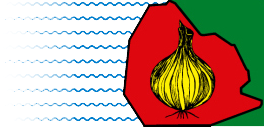[vc_row][vc_column width=”2/3″][vc_column_text]Do it Yourself
You can cultivate onions for yourself in most soil types, it could be that you do need to add some calcium (mostly when dealing with sandy and acid soil types). The substrate needs to be well fertilised. Organic and artificial manure are the best options, manure from stables attract the onion fly and are therefore not a good option. The organic manure needs to worked under the before growth season, during the growth season artificial manure can be used. Be careful not to over fertilise, this can influence the qualtiy. Furthermore it is wise to do yearly crop rotation, plant or sow onions once in six years on the same piece of land. This declines the risk for diseases and plaques and of soil depletion.
Cultivating seed onions
Compared to onion sets seed onion can be harvested later and stored better. What to do? From the moment the weather conditions allow it the onion seed can get into the ground; between the end of February and April. The later the seed is in the better it will germinate. Sow the onion seed in row with a space of 25 centimeters. Leave 5 to 7 centimeters between every seed, so each plant will have enough space to grow without the need of weeding out. Sow the seeds maximum 2 centimeters deep and press the ground solid. Keep the ground weed free for the following months. Harvest the onions in August to September and leave the onions on the soil to dry, when possible, for 1 to 2 weeks. Otherwise put the onions somewhere sheltered against moisture and wind, so the onions can dry. Storing seed Onions; Seed onions are best stored when dormant state. When you want to store the onions the best moment to harvest is when the leafage is bend over. Keep the onions frost free but in a cool. Do not wait too long with harvesting, because of damaging the skin which results in a higher chance of rot. How to store at home; Onions need to be firm, to have a dry outer skin and no offshoots. As mentioned before keep the onions on a dry cool (12 – 15 degrees Celsius), dark and dry place but outside the refrigerator. This way onions can be stored several weeks to 2 months. In a well closed plastic case you can keep chopped onion at minus 18 degrees Celsius, up to 3 months. Do check the onions regularly during storage, every damage to the skin can result in rotting and 1 rotten onion can contaminate others.
Cultivating Onion sets
If you choose for onion sets you have to know that the cultivation takes place over 2 years. The first year the onion sets are sown and grown, the second year you plant the onion sets. What to do? Sow te seed between the end of March and the begin April in a gully a few centimeters deep and the space between the plants about 1 to 1.5 centimeters. Leave about 20 centimeters between the gullies. When the onions start to grow you do not have to weed out any plants. Harvest the onion bulbs with an average diameter of 10 to 20 milimeters during the second half of June. Take the whole onions out of the ground. Leave the onions to dry so that the leafage dies. When the leafage is dead cut the leafage just above the onion bulb, this will prevent rotting. Store the onion bulbs (onion sets) between August and March, be sure it is under the right temperature, this can vary per onion set variety/race.
In March the next year the second year onion sets can be planted, keep between the rows a space of about 30 centimeters. Leave about 10 centimeters of space between the onion sets. Plant the onion sets to a depth that the tips of the onion sets are just showing through the soil. Do not push the onion sets into the ground. Cover the onion sets with ground and press the ground till it is solid, keep the ground weed free for the following months. When necessary use some fertilizer. The onions can be harvested from the beginning of July, or around half August when the leafage has died. How to store Onion sets; Onion sets can be stored for several month, on the condition that they are stored in a cool and dark place. Do not remove the dead leafage and the brown skin from the onion, these will protect it.
[/vc_column_text][/vc_column][vc_column width=”1/3″][vc_gallery interval=”5″ images=”1360,1319″ img_size=”medium”][/vc_column][/vc_row]
